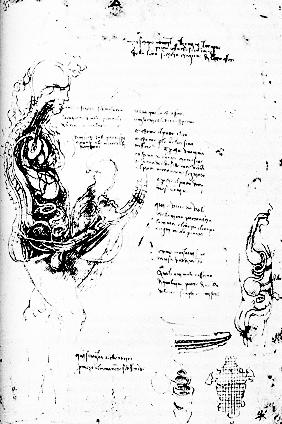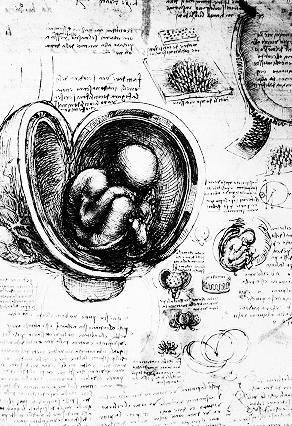|
|
||||||||||||
|
|
SEX RESEARCH
Two pages from the notebooks of Leonardo da Vinci showing anatomical studies of coitus (left) and of fetal development (right). Ironically, the medical campaign against masturbation was launched at a time when libertarian philosophers had begun to discard the ascetic Christian doctrines about sex, and when various explorers returned home with news of sexually uninhibited "noble savages" in distant parts of the globe. The French Capitain Bougainville and the English Captain Cook found sensuous, happy peoples in Tahiti and on other Pacific islands, and this discovery cast serious doubts on the sexual standards of Europe. Writers like Voltaire and Diderot openly criticized these standards as inhumane, and the French Revolution finally raised the demand for legal reforms and greater sexual freedom. In England, the traditional emphasis on reproduction was questioned by the pious but nevertheless pragmatic Thomas R. Malthus in his Essay on Population (1798), which predicted that sooner or later the increase in population would outrun the food supply. In order to avert this disaster, he advocated "self-restraint" and late marriage. However, such measures were soon deemed inadequate by more audacious spirits who therefore proceeded to popularize contraception. Perhaps the most important of these efforts was undertaken by the American physician Charles Knowlton in his book The Fruits of Philosophy, Or the Private Companion of Young Married People (1832). This volume, although written in a sober and even moralistic tone, offered the most comprehensive description of contraceptive techniques since the days of Soranus. Still, in spite of its scholarly merits, it displeased the authorities, and Knowlton was fined and imprisoned. This episode, among others, was a clear signal that the established powers were ready to take their stand. Western churches and governments were not interested in the progress of sex research and, in any case, did not want its results to be known to the general public. The following decades proved that the signal had been understood. Many researchers became themselves highly intolerant and remained content with defending the status quo. Psychiatry emerged as a new medical discipline. Its practitioners took up the fight against "self-abuse" and advanced ever more fantastic theories about its causes and consequences. The French psychiatrists Morel, Magnan, and Charcot strengthened the old morality by ascribing unconventional sexual behavior to "degeneracy" which produced sexua! "perversions". Russian, German, and Austrian doctors developed the concept of "sexual psychopathology" which was blamed for all deviations from the sexual norm. Finally, in 1886 the Viennese psychiatrist Richard von Krafft-Ebing deplored, listed, and classified these deviations in his influential textbook Psychopathia Sexualis. Just as the title itself, large portions of the text were written in Latin, so as to make them unintelligible to ordinary readers. (For details see "Conformity and Deviance—Healthy—Sick.") It was not until the beginning of our own century that a more critical attitude gained some ground. Sigmund Freud dismissed the concept of degeneracy and explained "abnormal" sexual behavior as the result of traumatic childhood experiences. At the same time, he offered a keen and unflattering analysis of modern civilization. More practical research was done by Havelock Ellis, Iwan Bloch, and Magnus Hirschfeld, who published voluminous studies of sexual behavior, thus laying the groundwork for a new academic discipline: "Sexualwissenschaft" (sex science) or "sexology". This kind of work was later continued by American scientists like Kinsey, Masters, and Johnson. Another important research effort concerned the venereal diseases. In 1906 Wassermann developed his famous test for syphilis, and in 1910 Ehrlich and Hata found the first successful cure. The discovery of penicillin by Fleming in 1928 then prepared the way for our present effective methods of treatment. The First World War (1914-18) shook the existing moral order and led to greatly increased sexual freedom. Women became more emancipated and rejected their traditional gender roles as too confining. They and other sexually oppressed groups found new arguments in the work of anthropologists who made cross-cultural studies of sex. Once more, the Pacific islands supplied the material for a moral lesson. In the 1920s and '30s Bronislaw Malinowski and Margaret Mead studied the Trobrianders, Samoans, and other "primitives", and confirmed that neither our Western ideals of sexual behavior nor our concepts of masculinity and femininity are universal. These studies also proved that greater sexual tolerance need not lead to moral decay. In 1951 Clellan S. Ford and Frank A. Beach summarized a vast amount of anthropological data in their book Patterns of Sexual Behavior and arrived at the same conclusion. Today, sex research continues on numerous fronts and is increasingly being accepted. Indeed, occasionally it is even taken too seriously or burdened with too many expectations. For instance, some laymen believe that modern sex research has produced entirely new human insights. However, this is only partially true. After all, the most "revolutionary" discoveries of Freud (infant sexuality), Kinsey (the great extent of homosexual behavior and the high sexual responsiveness of adolescents), and Masters and Johnson (the superior orgasmic potential of women) had already been common knowledge in ancient and medieval times. This knowledge had been suppressed only within the last few centuries and only in the industrialized West. Thus, in many cases our modern sex researchers have merely revived some very old truths. This realization does not take any credit away from recent accomplishments, but it shows that it may be useful to put them in some historical perspective. The following pages make this attempt by briefly describing the work of a few outstanding researchers. A concluding section deals with present concerns and possible future developments. |


